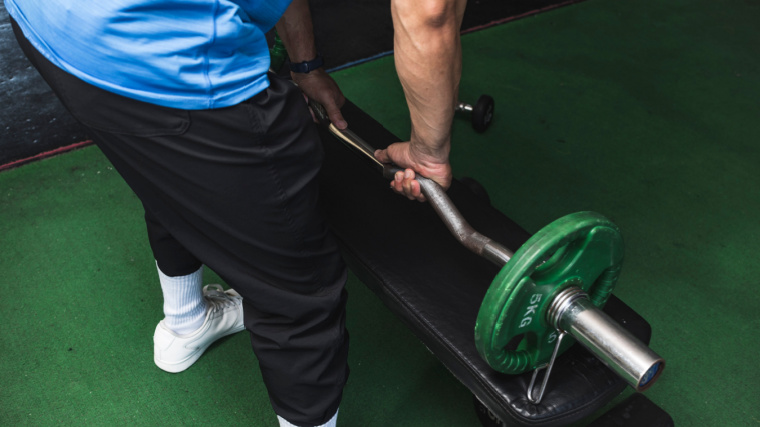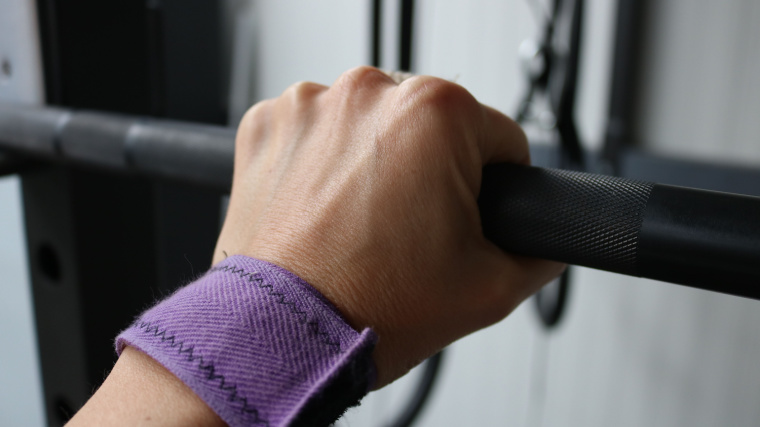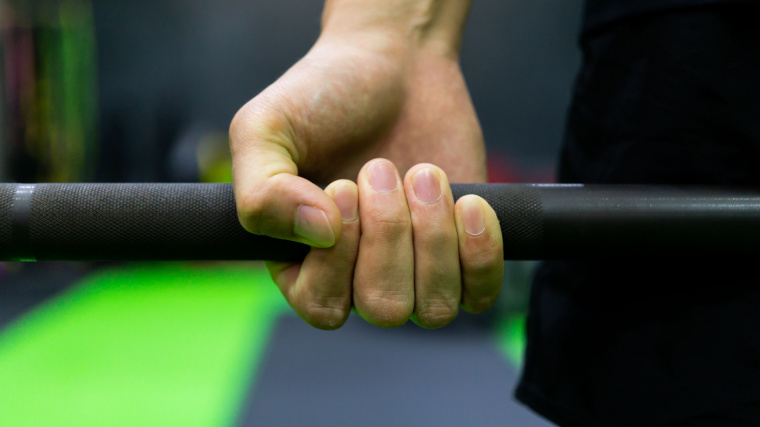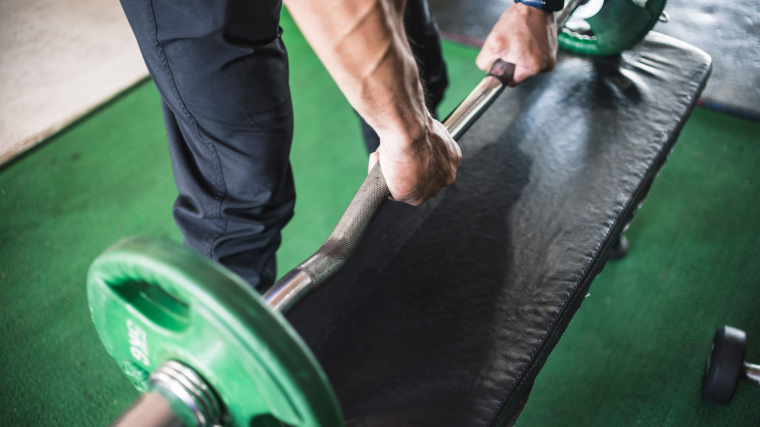You know how to grip a barbell. You take an overhand grip with your knuckles facing you, or your take an underhand grip with your knuckles facing away from you. It seems simple until you whip out fancy words like pronation and supination.
Fortunately, their definitions are fairly simple. In terms of grip, pronation refers to an overhand grip. On the other hand, a supinated grip is an underhand grip. The overhand grip is what you’ll use when you step up to the bar to press it overhead or clean it up to your shoulders. You’ll typically grab the bar with an underhand grip to do a classic biceps curl.

But is the pronated grip better than the supinated grip, or vice versa? Here’s your guide to everything you need to know about these grips — and how to choose when to use each orientation.
- What Is Pronation?
- What Is Supination?
- Pronated Grip Benefits
- Pronated Grip Drawbacks
- Supinated Grip Benefits
- Supinated Grip Drawbacks
- When to Use a Pronated Grip
- When to Use a Supinated Grip
- When to Use Both Grips
Editor’s Note: The content on BarBend is meant to be informative in nature, but it should not be taken as medical advice. When starting a new training regimen and/or diet, it is always a good idea to consult with a trusted medical professional. We are not a medical resource. The opinions and articles on this site are not intended for use as diagnosis, prevention, and/or treatment of health problems. They are not substitutes for consulting a qualified medical professional.
What Is Pronation?
Using a pronated grip means you’re using an overhand grip. Often, this will mean that your palms are facing away from you, as with an overhead press. However, it also sometimes means that your palms are facing toward you — think about a double-overhand deadlift.
To help this make sense, think about the fact that your grip doesn’t change during a clean & jerk. This starts similar to a deadlift, with an overhand grip or a hook grip. Your grip is pronated, and your palms will be facing toward your body. But as you perform your jerk, your palms will be facing away from your body — yet your grip is still pronated.

To further avoid any confusion and to help you keep track of which grip is which, you can think about pronation in terms of your forearms. Your forearms are in a more or less neutral position while you’re using a pronated grip.
What Is Supination?
A supinated grip is otherwise known as an underhand grip. With a supinated grip, your palms will often face upward or toward you. Think about a chin-up or reverse row, where your palms are facing you and your knuckles are facing away.

When your grip is supinated, your forearms rotate toward your body. Generally speaking, a supinated grip will give you more emphasis on your biceps and forearms.
Pronated Grip Benefits
Unless they’re looking to curl the bar, many lifters have the instinct to grab a barbell in an overhand grip. This is the grip you’ll typically use to do your biggest compound lifts, from overhead and bench pressing to squatting and deadlifting.
Sports-Specific Strength and Skill
Whatever your strength sport, you’ll use the overhand grip during your major lifts. This means that you’re just going to have to get strong with this grip — period. If you’re a weightlifter, your bread and butter is likely the hook grip.

As a powerlifter, you’ll need to crush bench presses. And even if you opt for a mixed grip, you need a strong overhand grip to make the most of your lift. CrossFitters do every lift from snatches, clean & jerks, and overhead presses. So if you’re looking to build sports-specific strength, you can’t avoid the pronated grip.
Increased Lat Activation
If you want a strong back, you need to use a pronated grip. Research suggests that using a pronated grip during a lat pulldown can activate your lats even more than using a supinated grip. (1) When you’re looking to crush your back accessory exercises and build wide lats, the pronated grip may well be your best friend.
Pronated Grip Drawbacks
You need to develop a strong pronated grip to get strong and powerful in major compound lifts. But that doesn’t mean you should always use this grip.
Lesser Grip Strength
Research suggests that the overhand (pronated) grip is typically weaker than the supinated grip. (2) So, you’ll likely be able to heft less weight with a pronated grip.
This can be an advantage if you’re looking to develop an emphasis on form and higher reps over heavier weights and lower reps. That said, building max strength requires lifting max weights. When you’re rowing and performing pulldowns, be sure to swap in heavier sets with a supinated grip.
Smaller Emphasis on Smaller Muscles
If your goal is to focus on your form and concentrate on your back, turn to the pronated grip. However, only lifting with an overhand grip may contribute to the neglect of your biceps and forearms. Especially if your program is extra full of compound exercises, you may find that your biceps and forearms start lacking if you’re only using a pronated grip.
Swapping in a supinated grip can help ensure that your biceps and forearms are getting enough action. Ultimately, this can turn around and make your pronated lifts plateau prematurely. Make sure you’re not only using a pronated grip to keep all your muscle groups up to par.
Supinated Grip Benefits
Flipping your palms to face up can be a real game-changer in the gym. A supinated grip can put help you emphasize overlooked muscles even while performing compound movements.
Increase Biceps and Forearm Activation
Don’t get it twisted — even rows, pulldowns, and chin-ups performed with a supinated grip should rely most heavily on your back muscles as primary movers. That said, if you’re switching to a supinated position, you will increase the tension on your biceps and forearms.
You may be looking to maintain an emphasis on compound movements in your program but still get in high-quality biceps and forearm work. In this case, reverse grip pulls can serve you very well.
Greater Grip Strength
The way you grip the barbell influences how well you can grip it throughout your set. Athletes’ grip strength may be greater in a pronated position than in a supinated position. (2) This means that you may be able to lift heavier weights for more reps with an underhand grip.
Being able to slide extra plates onto the bar can help athletes develop greater confidence in their lifts as well as increase their overall strength.
Adding Training Volume
Using a pronated (overhand) grip will maximally activate your lats during a lat pulldown. (1) That doesn’t mean a reverse grip lat pulldown is useless for your back, though. Less lat activation isn’t no lat activation.
Since the reverse grip will rely more on your biceps, you may actually be able to add more back training volume by helping out your exhausted lat muscles. In this way, reverse grip lat pulldowns or other reverse grip back exercises may serve as back finishers to add extra intensity and volume to your back workouts.
Supinated Grip Drawbacks
There’s nothing wrong with a supinated grip, but that doesn’t mean it’s useful in every circumstance. Here are some reasons you might not want to use a supinated grip.
Potential Strain on Your Biceps
Oftentimes, you use an underhand grip precisely to put more emphasis on your biceps — think about chin-ups and reverse-grip lat pulldowns. But there can be too much of a good thing.
In the case of a mixed-grip deadlift, one of your arms is supinated while the other is pronated. Though biceps tears during deadlifts are relatively rare, when they do occur, they tend to happen to the pronated biceps while using a mixed grip. (3)
That said, it should be noted that the supinated grip isn’t inherently dangerous. A large number of biceps tendon ruptures occur during weightlifting movements, which are often performed with a pronated hook grip. (4)
Not for Pressing
Supinated grips are just not always useful. For example, you likely want to avoid flipping your grip around for an overhead press or a bench press. Pressing exercises don’t generally mix well with a supinated grip.
There is a wide array of underhand-grip exercises to choose from. But due to the increased risks of dropping the bar down onto your face or chest with an underhand grip bench or overhead press, it’s definitely something you might want to consider carefully. If you do choose to integrate a reverse grip bench press into your program, a skilled spotter is definitely required.
When to Use a Pronated Grip
A pronated grip is necessary for your biggest barbell exercises. Essential competition lifts in weightlifting, powerlifting, and CrossFit all require a strong pronated grip. Make sure you’re integrating plenty of overhand grip exercises into your routine to give yourself the sports-specific practice and strength you need.
Even if you’re not a competitive strength athlete, the squat, deadlift, bench press, and overhead press likely all feature heavily in your program. Even outside of those lifts, practicing this lift can help orient your body and muscles to the position.
Since you use a pronated grip with your most fundamental strength-builders, start your workouts using a pronated grip. You can transition into using the supinated grip later in your session, but get your overhand grip lifts in first and foremost. You’ll likely have the most energy to attack those lifts with fervor, mental focus, and skill at the beginning of the workout.
Examples of Pronated Grip Exercises
For many exercises, like the lat pulldown or the barbell row, “reverse grip” refers to a supinated grip. But in the case of biceps exercises, which are generally performed with a supinated grip, it’s the pronated version that is dubbed the “reverse grip.”
- Deadlift
- Back Squat
- Clean & Jerk
- Pull-Up
- Inverted Row
- Barbell Row
- Overhead Press
- Bench Press
- Reverse Grip Biceps Curl
- Reverse Grip Preacher Curl
- Overhand Triceps Pushdown
- EZ Bar Skull Crusher
Because of the relative security of the pronated grip in both pushing and pulling exercises, the list of overhand grip exercises is fairly extensive.
When to Use a Supinated Grip
The supinated grip will help you develop well-rounded strength across your back and arms. Since an overhand grip will help you build the most amount of strength in your essential lifts, spend the first part of your workout using a pronated grip.
After you’ve completed your primary lifts, get plenty of practice with the supinated grip during your accessory work. You can do this by performing your last set of each applicable exercise with a supinated grip. For example, perform your first three sets of barbell rows with a pronated grip, then finish off your final set using a supinated grip.
[Read More: The Best Biceps Exercises for a Muscle-Building Workout]
Alternatively, you can program supinated grip exercises as your primary form of accessory work. You might opt to do this by using supinated grip-dominant work throughout an entire microcycle. Or, you might want to pepper supinated grip exercises alongside pronated accessories.
Throughout your program, if you want to place an emphasis on growing your biceps and forearms, make sure you’re including a lot of supinating exercises. This won’t only support your strength gains, but your hypertrophy goals, as well.
Examples of Supinated Grip Exercises
You can use a supinated grip with many pronated pulling lifts. For example, you can perform the following exercises (traditionally performed with a pronated grip) with a supinated grip:
- Chin-Up
- Front Squat
- Reverse Grip Inverted Row
- Reverse Grip Barbell Row
- Reverse Grip Lat Pulldown
- Biceps Curl
- Preacher Curl
- Reverse Grip Triceps Pushdown
[RELATED: Best Barbells]
You’ll notice that some big pronated compound exercises didn’t make it to the supinated list. Overhead presses and bench presses can very quickly become dangerous with alternative methods like reverse grips or thumbless grips.
When to Use Both Grips
Lifting is not all about pronation or supination. You can combine the two — quite literally meeting them in the middle — by using a neutral grip. This grip variation will generally involve your hands facing each other.
This grip is somewhere in the middle of both pronation and supination. Neutral grip exercises are often easier on your shoulders because — as the name suggests — the position is generally very neutral for your arms. This can mean your shoulders have an easier time with the movement.
If you struggle with bench presses or overhead presses due to shoulder pain, it might help to switch to neutral grip variations of these lifts. You may also want to use this type of grip if your forearms are tired and you want to perform your compound exercises while giving them a chance to recuperate. This grip also gives you yet another exercise angle to train from.
Examples of Neutral Grip Exercises
While you can’t perform neutral grip exercises with a barbell because of its unyielding shape, you can opt for a trap bar or Swiss bar instead. Both of these specialty barbells have neutral grip handles.
If you don’t have access to those bars or prefer free weights, you can use dumbbells, kettlebells, or even medicine balls to perform neutral-grip exercises.
- Trap Bar Deadlift
- Swiss Bar Bench Press
- Swiss Bar Row
- Swiss Bar Overhead Press
- Neutral Grip Dumbbell Press
- Renegade Row
- Hammer Curl
- Triceps Pushdown
There are also some movements that combine these grip styles. The mixed grip deadlift has one arm in supination while the other is in pronation. Moves like the Zottman curl will start with your grip supinated (palms facing up), while the eccentric portion will be pronated (palms facing down) in a reverse curl.
Pronation Vs. Supination — Who Wins?
The winner of this fight depends on your goals. If you’re looking to refine your barbell technique and strength in your biggest lifts, keep your program emphasis on pronation.
[Read More: Our Favorite Forearm Workouts, + the Best Forearm Exercises]
Still, be sure to include supine accessory exercises to make sure your lifts don’t hit an early plateau because your forearms and biceps can’t handle heavier loads. When you’re looking to build your arms, emphasize supination amidst all that pronation. In the battle of grip orientation, the winner ultimately hinges on balance.
References
- Lusk SJ, Hale BD, Russell DM. Grip width and forearm orientation effects on muscle activity during the lat pull-down. J Strength Cond Res. 2010 Jul;24(7):1895-900.
- Fan S, Cepek J, Symonette C, Ross D, Chinchalkar S, Grant A. Variation of Grip Strength and Wrist Range of Motion with Forearm Rotation in Healthy Young Volunteers Aged 23 to 30. J Hand Microsurg. 2019 Aug;11(2):88-93.
- Kapicioglu M, Bilgin E, Guven N, Pulatkan A, Bilsel K. The Role of Deadlifts in Distal Biceps Brachii Tendon Ruptures: An Alternative Mechanism Described With YouTube Videos. Orthop J Sports Med. 2021 Mar 25;9(3):2325967121991811.
- Lappen S, Siebenlist S, Kadantsev P, Hinz M, Seilern Und Aspang J, Lutz PM, Imhoff AB, Geyer S. Distal biceps tendon ruptures occur with the almost extended elbow and supinated forearm – an online video analytic study. BMC Musculoskelet Disord. 2022 Jun 22;23(1):599.
Featured Image: Sarayut Sridee / Shutterstock